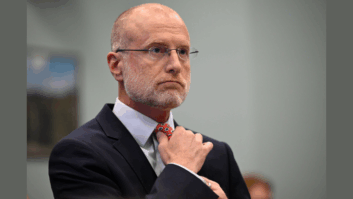
WASHINGTON — The FCC is sorting through several thousand filings on its media ownership rules. Some 10,000 public filings were made between mid-June and early January, for example.
An item to eliminate the newspaper/broadcast and TV/radio cross-ownership ban has been circulating among the commissioners. When Chairman Julius Genachowski started circulating a draft order late in 2012, the agency also released a study that showed media ownership among minorities was stagnant at 8 percent of radio and 3.6 percent of TV stations.
The chairman had been aiming to complete a vote on media ownership by year-end, however pressure from Commissioner Mignon Clyburn, Sen. Maria Cantwell, D-Wash., civil rights groups and consumer watchdog groups succeeded in a postponement until after comments were received on the study on minority ownership.
What follows are excerpts of public filings regarding some of the more pertinent issues.
Eliminate Newspaper/Radio Cross-Ownership Ban
Cox Media Group
Submitted by its attorneys at Dow Lohnes:
The commission should reverse its tentative proposal and abolish the newspaper/radio cross-ownership rule in its entirety. The commission’s tentative conclusion that “radio stations are not the primary outlets that contribute to local viewpoint diversity” has been recognized by the commission for many years, so the rule cannot be supported as necessary to promote the commission’s diversity policy. … [T]he commission has explicitly recognized that radio advertising constitutes its own product market for antitrust analysis; that radio is not a substitute for television or newspapers; and that radio stations do not make substantial contributions to original local news reporting. …
Abolition of the newspaper/radio cross-ownership prohibition would provide both newspapers and radio stations an opportunity to revitalize local news on radio. While the Pew News Media Usage Study shows that significant numbers of local residents turn to radio for news, evidence also suggests that much of that news is not locally gathered or produced.
Thus, radio news has a ready-made audience for local news, and daily newspapers have the newsgathering resources to provide high-quality content. The result of repeal should be that local newspapers’ acquisition of radio stations is limited only by the commission’s local radio ownership rules.
Repeal Radio/Television Cross-Ownership Ban
CBS Corp.
Submitted by its attorneys at Wiley Rein:
In the Notice of Proposed Rulemaking, the commission tentatively concludes that elimination of the radio/television cross-ownership rule is appropriate because the rule is no longer “necessary to promote the public interest.” …
The NPRMrecognizes that the radio/television cross-ownership rule is not necessary to protect competition because neither advertisers nor consumers consider radio stations and television stations to be good substitutes for one another. This conclusion is amply justified, particularly because, as the FCC notes, the Department of Justice has long considered the radio advertising market to be a separate antitrust market, and the commission itself has found “that the video programming market is distinct from the radio listening market.”
Although CBS is committed to delivering high-quality local news through its radio stations, these findings undermine any attempt by the agency to justify the local radio ownership rule based on localism concerns. …
Freely allowing radio stations and television stations to combine their operations, moreover, will enhance competition, localism and diversity. Such station combinations will operate more efficiently, and have natural incentives to pass along the resulting cost savings to consumers in the form of better programming.
Don’t Relax NBCO
Free Press
S. Derek Turner, research director:
Free Press urges the commission to abandon its proposal to relax its newspaper broadcast cross-ownership (NBCO) rule. A nearly identical relaxation of this rule adopted in 2007 (and vacated by the Third Circuit on notice grounds) was roundly rejected by the public and policy makers. The NBCO rule remains necessary to promote access to independent and diverse local news sources, and allowing more cross-ownership leads to a curtailment of local news at the market level. …
Free Press urges the FCC to approach with caution its proposal to repeal the radio/television broadcast rule. Evidence suggests that consolidation disproportionately affects opportunities for women and people of color to become and remain broadcast stations owners. It is especially important not to reduce entry points for these groups in the radio industry, with its relatively low barriers to entry at least as compared to television ownership.
Free Press supports the FCC’s conclusion that it should retain its other media ownership limits, including the local radio rule and local television rule. These rules remain necessary to promote the public’s access to independent and competing sources of local news and information.
Local Radio Limits Are Obsolete
National Association of Broadcasters:
Radio broadcasters compete against many broadcast and non-broadcast audio outlets for audience share and advertising revenues and the number of new non-broadcast audio outlets continues to grow. Technologies that did not even exist when Congress set the current radio ownership limits, such as Internet radio, satellite radio and various mobile devices, have not only emerged as competitors to local radio broadcasters, but now permeate the audio marketplace. …
Moreover, as listeners, especially younger listeners increasingly turn to new non-broadcast audio platforms, local radio broadcasters struggle to maintain their audience shares and, thus, their advertising revenue. These decreased revenues, in turn, make it increasingly challenging for local radio broadcasters to continue providing high quality programming and local services.
Eliminate AM/FM Subcaps
National Association of Broadcasters:
The NPRMconcludes that the AM/FM subcaps are necessary to protect competition in local radio markets because of technical and marketplace differences between AM and FM stations, apparently assuming that AM stations are not competitive. That assumption is not valid. Not only are five AM stations ranked in the top 10 radio stations in the country by revenue, but 187 AM stations are ranked in the top five radio stations in their local markets in terms of audience share across the day.
Further, recent changes to the FM translator rules and the growth of digital audio broadcasting, HD radio technology and online streaming all provide new opportunities for AM stations to compensate for technical difficulties relative to FM stations and enhance their already strong presence in the audio marketplace.
NAB also disagrees with the conclusion that the subcaps increase diversity by promoting new entry into broadcast radio ownership. Elimination of the subcaps could well spur market activity through the divestiture of stations, creating ownership opportunities for new market participants, including small businesses and minority- and women-owned businesses.
CBS Corp.:
If the commission … determines that it should continue to restrict local radio ownership, it should eliminate the “subcaps” on ownership of AM and FM stations. The subcaps were historically premised upon supposed technological and marketplace disparities between AM and FM stations which have been eradicated by the increasing competitiveness of AM stations and the advent and increasing utilization of digital radio technology. As the record compiled in response to the initial Notice of Inquiry in this proceeding conclusively demonstrated, the subcaps have long been unsustainable, are even more so now, and cannot lawfully be maintained as an aspect of any local radio ownership rule that might be left in place.
Eliminate or Relax Local Radio Ownership Limits
CBS Corp.:
[T]he explosion of alternatives to radio and the ever-expanding nature of the contemporary audio programming marketplace has eviscerated any competition- or diversity-based justification for restricting local radio ownership. Today, radio competes with a plethora of new media, many of which did not exist or were in their infancy when the agency last revised the rule. To say that the rule remains necessary to promote competition in these market circumstances simply makes no sense.
By maintaining outmoded restrictions on the number of over-the-air stations that can be owned in a local market, the commission’s current regulatory regime also singles out radio alone for regulation. Restricting a single entity from owning more than eight stations in the largest markets — when a single satellite radio licensee can operate a system with hundreds of channels that serve every market in the country — is unjustifiable. …
Tighten Radio Ownership Limits
musicFirst Coalition
Submitted by Ted Kalo, executive director. The organization consists of the American Federation of Television and Radio Artists, The Recording Academy & American Federation of Musicians:
In its NPRM, the commission seeks comment on whether to change numerical ownership limits for local radio. These ownership limits should certainly not be weakened. In fact, it is our firm view that the FCC should tighten these ownership limits to reverse the rampant homogenization and impoverishment of radio programming in recent decades and to restore radio’s public interest service. …
Now, powerful national radio groups own numerous stations around the country and exercise unreasonable control over the airwaves. For example, one entity — Clear Channel — currently operates more than 850 radio stations, reaching more than 110 million listeners every week. Now merged with Citadel, Cumulus Broadcasting owns 570 stations in 120 U.S. cities and distributed network programming to 4,500 affiliates nationwide. ..
The issue of homogenized nationwide playlists has been substantially aired before the commission. Yet despite commission consent decrees with the nation’s four largest broadcasters mandating more airplay of artists on independent record labels, radio stations have not measurably diversified their playlists — the radio landscape remains a wasteland of homogeneity.
We vehemently object to any further loosening of the current numerical limits on the number of radio stations that can be owned by one entity in a given market — including the largest markets — and we believe that the public interest in competition, diversity and localism would best be served by decreasing the number of radio stations that one entity can own in any given market. For creators and distributors of recorded music, radio consolidation has created bottlenecks that block new artists from reaching radiolisteners.
Consolidation Has Broken Radio in America
musicFirst Coalition:
Thanks to widespread consolidation among broadcasters that push narrow, safe, national playlists, radio in America provides no appreciable benefit to up-and-coming artists or listeners interested in anything outside the top 10 hits from the last 50 years. Giant radio conglomerates even use their outsized strength to squeeze the few artists who receive airplay. It is self-evident that loosening the number of stations owned in any given market, including the largest markets, would exacerbate the harms consolidation had caused to the public interest and to music creators.
Radio in America is broken. We urge the FCC to impose stricter ownership limits on the broadcast radio industry to reaffirm radio’s commitment to the public interest.
Reduce the Subcaps
Saul Levine, President, Mt. Wilson FM broadcasters, Los Angeles:
The 1996 Telecommunications Act is not an obstacle to reducing caps and subcaps. The Act allows the commission to repeal or modify rules which are no longer in the public interest. The 39 percent radio ownership decline through 2007 (and an obvious further decline through 2011) is not in the public interest as is defined by the commission’s policy goals. The matter of size, the noted outside factors, the failure not to count commonly owned out-of-market HD Radio stations carried in a distant market constitute factors which adversely affect the policy goals. …
If the policy goals are truly intended to foster a healthy and competitive public interest structure, i.e., survival, competition, localism, diversity and jobs, then reduce the caps and subcaps. Absent affirmative modification of the rules, the only beneficiary is Wall Street (not to be confused with the public interest). Insofar as the future of the independent owner, the status quo equates to the last-minute extension of a death sentence.







